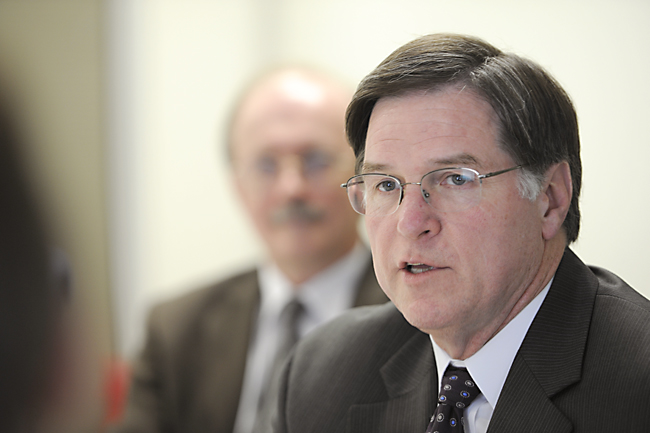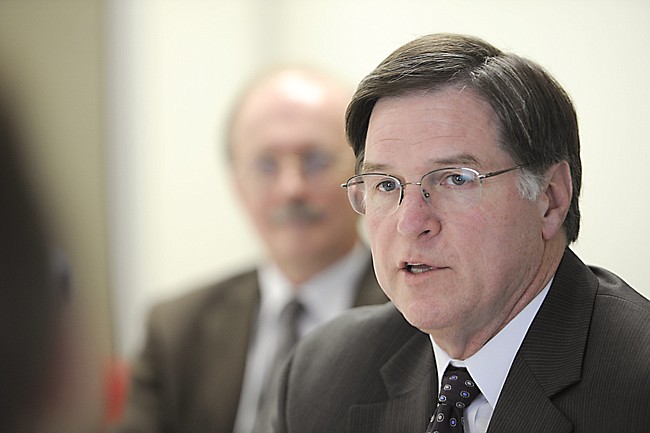 Bill McCollum, chief operating officer of TVA, and Ian McLeod, TVA spokesman, speak at a news conference regarding nuclear power safety in Chattanooga at the TVA Office of Power. Concerns have been raised regarding the use of nuclear power after the meltdowns from the natural disasters in Japan.
Staff Photo by Jenna Walker/Chattanooga Times Free Press
Bill McCollum, chief operating officer of TVA, and Ian McLeod, TVA spokesman, speak at a news conference regarding nuclear power safety in Chattanooga at the TVA Office of Power. Concerns have been raised regarding the use of nuclear power after the meltdowns from the natural disasters in Japan.
Staff Photo by Jenna Walker/Chattanooga Times Free PressThe Tennessee Valley Authority is moving ahead with construction and planning for more nuclear reactors despite the explosion and ongoing radiation leaks at one of Japan's largest nuclear plants.
TVA Chief Operating Officer Bill McCollum Jr. said Wednesday that the federal utility established a centralized response center in Chattanooga to assess the accident at Japan's Fukushima Dai-ichi plant - which was damaged by an earthquake and tsunami - and to evaluate TVA plants' vulnerability to natural or manmade disasters.
While some equipment, training and operating changes are likely at TVA nuclear facilities, McCollum insisted the plants are safe. He said suspending work on new plants would only inflate costs and possibly impede their successful completion.
"I think it's premature, given that we haven't gotten all of the information about the events in Japan, to make any changes," McCollum said during a media briefing in Chattanooga.
Since the Japanese nuclear disaster, Russia, China and Germany have announced plans to suspend work on new nuclear projects. Nuclear opponents have called for a similar moratorium on new nuclear projects by TVA.
The utility is spending nearly $1 million a day to finish building a second reactor at its Watts Bar Nuclear Plant near Spring City, Tenn. It's the only active nuclear plant now under construction in America and the projected completion date is 2013. TVA also is spending nearly as much - $248 million in the current fiscal year - for engineering studies on the possibility of finishing an incomplete unit at its Bellefonte Nuclear Plant near Scottsboro, Ala., as soon as 2018.
Nuclear Moratorium
Glenn Carroll, coordinator of the anti-nuclear power group Nuclear Watch South, said TVA's Sequoyah and Watts Bar plants are "the most vulnerable reactors to containment failure" because of their less robust ice condensers.
Three of the six reactors at the crippled Japanese plant share the General Electric boiling-water reactor design used at TVA's Browns Ferry Nuclear Plant and 29 other U.S. reactors.
"The time is ripe to build momentum to stop construction of new reactors and shut down old reactors," Carroll said.
Edwin Lyman, senior scientist for the Union of Concerned Scientists, said utilities and regulators need to reconsider their assumptions and design criteria after the failure of so many safety systems at Fukushima.
Lyman said the lack of any nuclear plant accident since Three Mile Island in 1979 "has made regulators and operators too casual about the severe accident risks at a nuclear plant."
But McCollum said TVA's nuclear plants are designed, built and operated to withstand earthquakes and flooding and are less likely to be crippled by such disasters than the Fukushima plant.
"It's important to understand that the designs of the Japanese plants are somewhat different and there are features built into our plants that make them more robust in terms of being able to deal with these sorts of natural disasters," he said.
TVA plants have hardened vents to prevent the type of hydrogen gas explosions that damaged four of Fukushima's reactors, he said. TVA also has put in more backup power and steam-generating pumps than in the Japanese plant so water will keep circulating even if the power fails.
The main source of backup power - diesel generators that can start up in a matter of seconds - are designed to withstand major floods or storms and are less likely to fail than Japanese equipment did in the tsunami, he said.
The risks of a major earthquake or sudden flooding in the Tennessee Valley also are far lower than in Japan, McCollum said.
